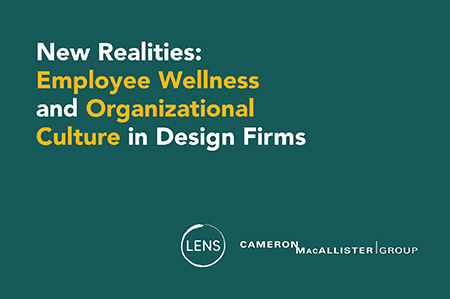 Over the last several years, organizations and professionals in the design industry have searched for their “new normal” amidst the disruptions of the coronavirus pandemic, the great reshuffle, and volatile social, political, economic, and environmental conditions. For many, a sense of normality or even stability has proven elusive. Many of our clients tell us they continue to worry about employee morale, mental health and wellbeing, and the health of their firms’ cultures.
Over the last several years, organizations and professionals in the design industry have searched for their “new normal” amidst the disruptions of the coronavirus pandemic, the great reshuffle, and volatile social, political, economic, and environmental conditions. For many, a sense of normality or even stability has proven elusive. Many of our clients tell us they continue to worry about employee morale, mental health and wellbeing, and the health of their firms’ cultures.
We have heard from firms that have experimented with ways to address the situation, adopting hybrid work policies, introducing wellness benefits, and devoting significant time and resources to firm culture initiatives. Still, many employers continue to report that morale remains low while stress levels and the prevalence of mental health issues in the workplace soar.
While anecdotal evidence on this issue abounds, there is little industrywide data available about how design professionals are experiencing the workplace today or about how organizational dynamics might be tied to social and emotional wellbeing at work. Without this evidence, firm leaders were left to guess at what might be happening industrywide and about how to best help their current and prospective employees thrive within their particular organizations.
Cameron MacAllister Group and Lens undertook a national study on organizational culture and employee wellness in the fall of 2022 to address this gap. The full report can be downloaded here.
This study asked the employees of participating firms to answer a short survey about their experiences in their current organization and aimed to address several key areas of inquiry:
- What are our employees really experiencing in the new hybrid work environment?
- What are the elements of the architectural workplace that are building healthy culture? What isn’t working?
- What are systemic issues that support or hinder wellness in the workplace?
- Are there demographic differences in how employees are responding to their current workplace culture?
- What are firms doing to address these questions?
Analysis of data collected through the survey yields several key insights about employee health and wellness in the design industry today:
- Firms across the industry are navigating significant cultural tensions as they establish their new normal – and employees feel it.
- Design industry professionals are more likely to experience inclusion and psychological safety at work than in the past, but race and gender-based differences in experience persist.
- Design industry professionals suffer from burnout in the workplace.
- These social-emotional wellbeing issues are compounded by work-life concerns.
- Young professionals are struggling with interpersonal, burnout, and mental health issues in design workplaces, with Millennial professionals at particular risk.
- There are gaps in the ways that interior designers and other design professionals experience design firm culture and workplace wellness, suggesting that role-based inequities exist within the industry.
- Mental wellbeing is a key driver of turn-over in design firms today.
Taken together, these findings indicate that there are strong correlations between mental health and organizational culture in the design industry and that these links may be able to explain the ongoing patterns of burnout, anxiety, and low morale that firm and industry leaders have observed, even after introducing work-life benefits such as hybrid and remote work and flexible scheduling. To comprehensively address these issues in a time of ongoing disruption, firm leaders will likely need to invest in holistic yet flexible action plans that align firm and team culture, organizational strategy, and work-life policy and practices.
This study was a collaboration between Cameron MacAllister Group (Saskia Dennis-van Dijl, Tina McGurk, Tiffany Bergeron) and Lens (Annelise Pitts). Overall, the survey garnered 2,750 responses from 57 firms. Respondents reported working in 41 states across the United States, three Canadian provinces, and several additional international locations.